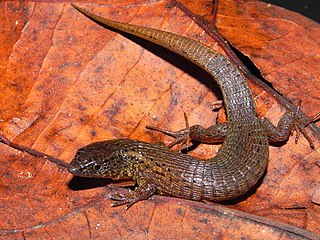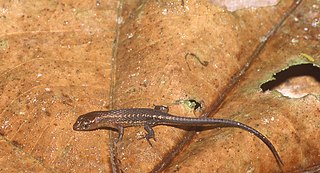
Alopoglossus is a genus of lizards in the monogeneric family Alopoglossidae. The genus is distributed from Costa Rica in Central America to northern South America.

The Andean emerald is a species of hummingbird in the "emeralds", tribe Trochilini of subfamily Trochilinae. It is found in Colombia, Ecuador, and Peru.
Lepidoblepharis buchwaldi is a species of gecko, a lizard in the family Sphaerodactylidae. The species is endemic to Ecuador.

Anolis podocarpus is a species of anole lizard in the family Dactyloidae. It was first described by Fernando P. Ayala-Varela and Omar Torres-Carvajal in 2010, the type locality being the Podocarpus National Park at Romerillos Alto in Zamora-Chinchipe Province, Ecuador on the southeastern slopes of the Andes. The specific name refers to the Podocarpus trees which are found in the Park.

Alopoglossus angulatus, known commonly as the northern teiid, is a species of lizard in the family Alopoglossidae. The species is endemic to northern South America.
There are two species of lizard named northern teiid:
Alopoglossus atriventris, known commonly as the keel-bellied shade lizard, is a species of lizard in the family Alopoglossidae. The species is endemic to northwestern South America.
Alopoglossus buckleyi, also known commonly as Buckley's shade lizard and Buckley's teiid, is a species of lizard in the family Alopoglossidae. The species is native to northwestern South America.
Alopoglossus copii, known commonly as the drab shade lizard, is a species of lizard in the family Alopoglossidae. The species is native to northwestern South America.
Alopoglossus embera is a species of lizard in the family Alopoglossidae. The species is endemic to western Colombia.

Alopoglossus festae is a species of lizard in the family Alopoglossidae. The species is native to northwestern South America.
Alopoglossus lehmanni is a species of lizard in the family Alopoglossidae. The species is endemic to western Colombia.
Alopoglossus meloi is a species of lizard in the family Alopoglossidae. The species is endemic to northern Brazil.

Alopoglossus bicolor, Werner's largescale lizard, is a species of lizard in the family Alopoglossidae. It is endemic to Colombia.
Alopoglossus bilineatus is a species of lizard in the family Alopoglossidae. It is found in Colombia and Ecuador.
Alopoglossus brevifrontalis, Boulenger's largescale lizard, is a species of lizard in the family Alopoglossidae. It is found in Ecuador, Peru, Bolivia, Brazil, Colombia, Venezuela, Guyana, and Suriname.
Alopoglossus gorgonae is a species of lizard in the family Alopoglossidae. The species is native to northwestern South America.
Alopoglossus amazonius, the Amazonanian teiid, is a species of lizard in the family Alopoglossidae. It is endemic to Brazil.
Alopoglossus harrisi is a species of lizard in the family Alopoglossidae. It is found in Ecuador and Colombia.






